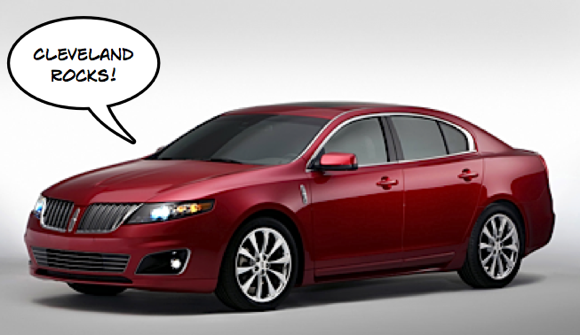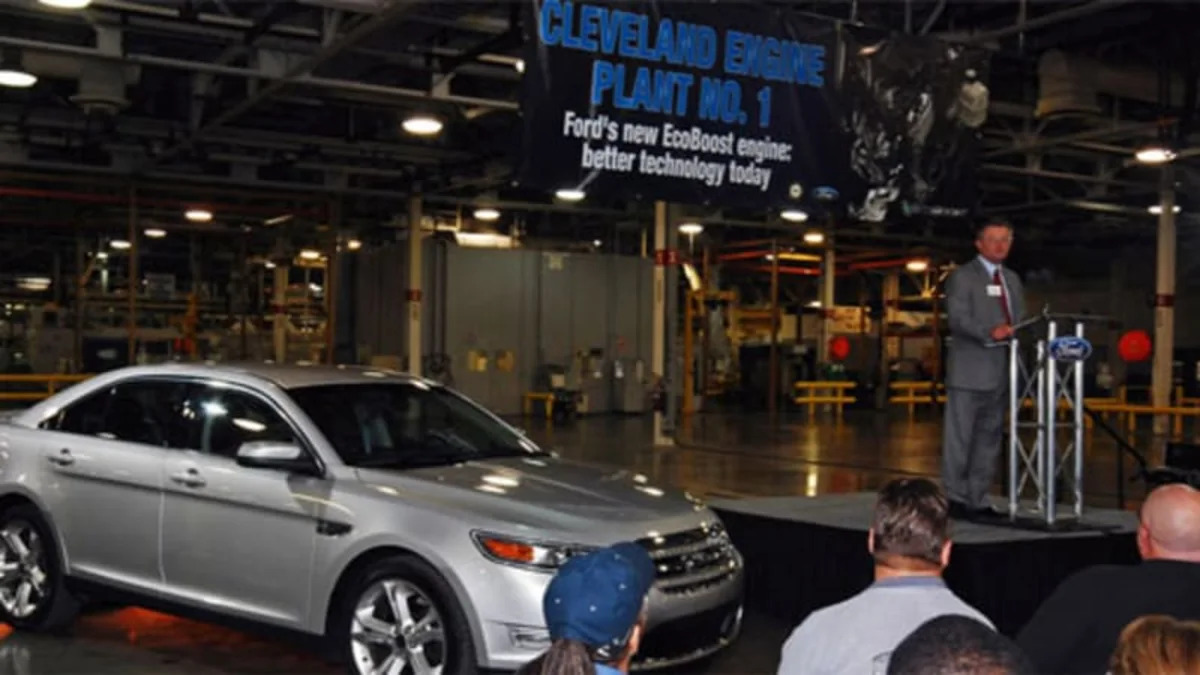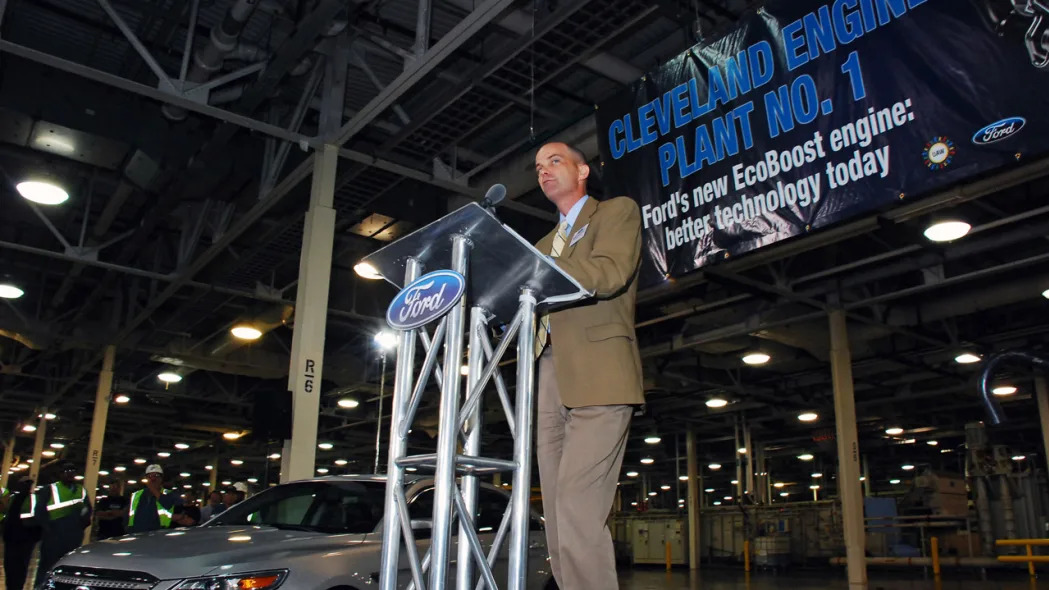On the same day that President Obama announced tough new CAFE standards for new cars in the coming half-decade, Ford began production of its new, more efficient EcoBoost engine in Ohio. As Green Car Advisor says, Ford couldn't have picked a better day. The new 3.5-liter EcoBoost V-6 engine will first make its way into the Ford Flex, Ford Taurus SHO, Lincoln MKS sedan and Lincoln MKT crossover vehicles. The turbocharged engines deliver a fuel economy boost of around 20 percent without an expensive hybrid powertrain. Ford says that 90 percent of its models will be available with EcoBoost engines by 2013.
Production started yesterday at the Cleveland Engine Plant No. 1, located in Brook Park, Ohio. This plant first opened in 1951 and currently employs 250 people. Ford announced that the plant, which had been closed since 2007, would be reopened to build the EcoBoost engines back in February. Read more about the EcoBoost technology here and here and after the jump.
Production started yesterday at the Cleveland Engine Plant No. 1, located in Brook Park, Ohio. This plant first opened in 1951 and currently employs 250 people. Ford announced that the plant, which had been closed since 2007, would be reopened to build the EcoBoost engines back in February. Read more about the EcoBoost technology here and here and after the jump.
[Source: Ford]
PRESS RELEASE:
FACT SHEET: CLEVELAND ENGINE PLANT NO. 1
Plant Information
* Plant name: Cleveland Engine Plant No. 1
* Location: Brook Park, Ohio
* Employment: 250 (210 hourly; 40 salaried)
* Products: 3.5-liter EcoBoostTM V-6 engine for Ford Flex, Ford Taurus SHO, Lincoln MKS sedan and Lincoln MKT crossover
* Year opened: 1951
* Site size in acres: 93
* Plant size in square feet: 1.6 million
* Product history: More than 35 million engines, including the renowned 351 Cleveland series and 24.3 million engines in the popular 302 and 5.0-liter V-8 family
Manufacturing Upgrades
* In 2004, Ford invested $350 million for plant redesign and installation of an all-new assembly line as well as block, crankshaft and cylinder head machining lines
* An additional $55 million was invested for tooling and equipment upgrades needed to produce the EcoBoost engine, including a flexible powertrain manufacturing system
* A new production database provides a "birth history" for each engine, tracking hundreds of metrics and allowing any quality control issues to be quickly and accurately isolated

Click above for a gallery of the 2010 Lincoln MKS
A NEW ERA DAWNS FOR FORD WITH START OF ECOBOOST ENGINE PRODUCTION AT STORIED CLEVELAND PLANT
Production of Ford's EcoBoost engine begins at Cleveland Engine Plant No. 1.
Login to download images.
* Cleveland Engine Plant No. 1 becomes the first Ford manufacturing site to produce advanced fuel-efficient EcoBoost engines
* Ford invests $55 million to retool and reopen Cleveland Engine No. 1; 250 jobs have been added to the plant to produce the new engines
* EcoBoost uses gasoline turbocharged direct-injection technology for up to 20 percent better fuel economy, 15 percent fewer CO2 emissions and superior driving performance versus larger displacement engines
* EcoBoost will first be available this summer on the 2010 Lincoln MKS, Lincoln MKT, Ford Taurus SHO and Ford Flex, expanding availability to 90 percent of Ford's nameplates by 2013
CLEVELAND, May 19, 2009 – Ford Motor Company today marked the start of production of its advanced fuel-efficient EcoBoost engines at Cleveland Engine Plant No. 1 – a key step in Ford's plan to deliver leading fuel economy across millions of vehicles.
Ford invested $55 million to retool and reopen the plant, which had been idled in 2007. Approximately 250 employees are returning to the plant to build the new engines.
EcoBoost technology combines turbocharging and direct gasoline injection to deliver up to 20 percent improved fuel economy, 15 percent fewer CO2 emissions and superior driving performance compared with larger displacement engines. The "downsize and boost" strategy provides consumers better fuel economy without sacrificing the power they want for driving performance.
For more information:
Ford Taps New Manager to Oversee Cleveland Site, EcoBoost Production
Fact Sheet: Cleveland Engine Plant No. 1
New EcoBoost V-6 Endures Engine 'Boot Camp'
Collaboration with Partners Key to EcoBoost's Industry-Leading Fuel-Charging System, Output
Technology Fact Sheets
"This launch of the first EcoBoost engine is a significant milestone in Ford's overall commitment to deliver affordable fuel efficiency for millions," said Barb Samardzich, vice president, Global Powertrain Engineering. "We've spent the past two years developing EcoBoost technology and now our customers will finally have the opportunity to experience what this engine delivers, the power of a V-8 with the fuel economy of a V-6."
About EcoBoost
The 3.5-liter EcoBoost V-6 engine, the first V-6 direct-injection twin-turbocharged engine produced in North America, will make its debut in the 2010 Lincoln MKS, Lincoln MKT, Ford Taurus SHO and Ford Flex this summer. A V-6 EcoBoost engine will be available for the F-150 in 2010.
Ford will deliver EcoBoost across the full range of its product portfolio, from small cars to large trucks and by 2013, will offer EcoBoost engines, V-6s and I-4s, on 90 percent of its North American nameplates. Within three years, Ford expects to deliver 750,000 EcoBoost-equipped vehicles per year in North America and 1.3 million vehicles globally.
The 3.5-liter EcoBoost V-6 engine delivers 355 horsepower and a responsive 350 ft.-lb. of torque across a broad RPM range.
New Life for Historic Plant
Cleveland Engine Plant No. 1 opened in 1951 as Ford's first engine plant in Ohio. Since then it has produced more than 35 million engines, including 24.3 million engines in the famous 302 and 5.0-liter V-8 family. In 2004, Ford invested $350 million into the plant for redesign and installation of an all-new assembly line as well as block, crankshaft and cylinder head machining lines.
Cleveland Engine Plant No. 1 has been outfitted with a flexible powertrain manufacturing system that can be easily reprogrammed to perform new tasks with minimal disruption to production.
"The ability to reprogram on the fly is a key feature of this new manufacturing system," said Charles Binger, Cleveland site manager. "We don't have to shut down an entire plant in order to make major changes to the line, helping to speed up modifications and keep downtime to a minimum."
Plant upgrades also included a special turbocharger installation and test line. After the turbos are added, each EcoBoost engine is turned on speeds between 60-600 RPM using an electric motor to simulate running conditions. Unique to the Cleveland site, this "cold test" checks for proper buildup of pressure on the turbo output side before the engine ever leaves the factory.
To ensure quality is built into the engine from the outset, Ford developed a new, internal database for its operations. Each engine will be built with a sophisticated, embedded engine "birth history" that allows plant engineers to track every stage of production.
The engine history, maintained in a microchip database, includes hundreds of metrics and allows engineers to trace the precise path taken by any part so any quality control issue can be traced back to its source.
Extensive Employee Training
To prepare for production of the EcoBoost engine, Cleveland Engine Plant No. 1 work force participated in intensive quality training. Along with learning basic manufacturing operations, employees also learned to manage their own equipment and work area through "manufacturing work teams" at the facility.
"Training workers to do their jobs is one thing," said Kevin Heck, Cleveland Engine No. 1 manufacturing manager. "But we've gone beyond that by giving team members significant responsibility for their output. It's up to the hourly team members to produce a high-quality engine, and we've empowered them to make that happen."
"We're proud of the efforts we've made to improve quality," said Mike Gammella, president, UAW Local 1250. "We have an outstanding work force at the Cleveland site, working together to ensure we're not just competitive, but the best in the industry."
Production Innovations through Supplier Collaboration
The twin-turbocharged 3.5-liter EcoBoost V-6 engine's enhanced fuel-charging system can deliver as much as 2,150 PSI of fuel pressure – more than 35 times the pressure seen in a conventional port-fuel-injected V-6. Ford worked in tandem with Bosch, the fuel system supplier, to ensure that manufacturing and assembly was prepared for the demands of the advanced design.
"The EcoBoost line has a fully automated fuel-charging assembly and rundown station," said Joseph Basmaji, Ford direct injection fuel system technical specialist. "It's a new technology in manufacturing that's only been made possible by close collaboration between Ford and our suppliers."
###
About Ford Motor Company
Ford Motor Company, a global automotive industry leader based in Dearborn, Mich., manufactures or distributes automobiles across six continents. With about 205,000 employees and about 90 plants worldwide, the company's automotive brands include Ford, Lincoln, Mercury and Volvo. The company provides financial services through Ford Motor Credit Company. For more information regarding Ford's products, please visit www.ford.com.



Sign in to post
Please sign in to leave a comment.
Continue